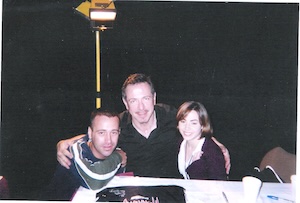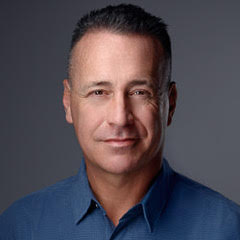Halloween Haunts: Horror Influences
By Dean Cade
I never planned on becoming a writer. The seeds were planted since I was a horror fan from a young age. My earliest memory of being scared in a theater was seeing the horror film, Prophecy, in the early summer of 1979. There was a scene towards the end that changed my life. The survivors were hiding in some kind of underground chamber, whispering and debating about the mutant bear somewhere up above. I wanted them to stay where it was safe and not open the trapdoor, but characters never listen and do dumb things. A guy opened it, and the bear slashed him. Visceral and intense, the killer mutant bear scared the crap out of me. The film gave me nightmares. At eight years old, it was the last time I asked to sleep in my mom’s room, sure that something under the bed or waiting just outside the window was going to get me.
Back in those days, films would play in theaters again after their release. My next underage trip to the theater was to see Carrie, and something different happened. During the climax, Carrie is injured while her mother makes the sign of the cross with a butcher knife. My mother was ready to leave, but I wanted to see what happened next. She was trying to pull me out of the small, two-screen theater in Pasadena, Texas. I hung on to one seat, got pulled down the aisle, and hung on to the next as the knives flew across the screen. From that moment on I was drawn to horror.
Late-night television would play classic Universal Monster films, Hammer Horror, and 1950s schlock, and I would purposely stay up late. One prime time example that stood out was Salem’s Lot, a Stephen King miniseries about a small town besieged with vampires that was filled with some scenes of pure horror, from the vampire in the rocking chair to the undead kid floating and scratching at another kid’s bedroom window in the middle of the night. Next came glorious cable, new to the neighborhood in 1982, showing films like Friday the 13th, The Howling, The Shining, It’s Alive, and Humanoids from the Deep in the middle of the day with no restrictions. Finally, by 1983, a barrage of horror titles flooded in with the boom of home video. There were so many taboo-looking boxes promising terrible sights. One of my favorite spots was a twenty-four-hour Shell station that rented movies. I saw everything I could, drinking in the chaos.
The movies drove me to the horror section of the bookstores, where I sought the works of Stephen King. The first book purchased was Salem’s Lot, the edition with the black cover and red drop of blood. I found it differing from the miniseries in tone and style. I moved onto Carrie, Cujo, Christine, The Shining, Night Shift, Pet Sematary, Firestarter, The Talisman, Cycle of the Werewolf, and others, discovering the differences when they were adapted into films—the character beats, the inner dialogues, and scenes of terror amplified by my imagination. King has the special ability to take the normal, whether it be a family, a small town, or a pet, and inject pure horror into it, making the story have frisson. Any way I could get my hands on the books, I would. I was hooked on the escapism. In rehab in 1985, I had my collection with me for a short while along with issues of Fangoria magazine until the staff decided they were detrimental and had them taken away. My teenage life was crazy, but the fictional horror stories took me to other places of dreams and nightmares.
 Stephen King led to Clive Barker with his quote, “I have seen the future of horror…” With King’s recommendation and the coverage of Rawhead Rex, Transmutations, and Hellraiser in Fangoria, I was sold on Clive. I dived into the Books of Blood as soon as I could, shocked and delighted with the vocabulary (some I had to look up) and more dark fantasy than horror. I devoured all of his extreme shorts, then went into other realms with Weaveworld, The Damnation Game, and The Great and Secret Show. Later on, discovering Clive was gay was a revelation—a role model—another lost soul who found a path. Sacrament is one of my favorite books. The protagonist, Will, is gay and a wildlife photographer documenting the extinction of species. He finds a supernatural being split in two, male and female, that is on a quest to destroy the last of things. “Living and dying, we feed the fire.” Clive Barker’s books were extreme but smartly written, and they appealed to the outsider in me.
Stephen King led to Clive Barker with his quote, “I have seen the future of horror…” With King’s recommendation and the coverage of Rawhead Rex, Transmutations, and Hellraiser in Fangoria, I was sold on Clive. I dived into the Books of Blood as soon as I could, shocked and delighted with the vocabulary (some I had to look up) and more dark fantasy than horror. I devoured all of his extreme shorts, then went into other realms with Weaveworld, The Damnation Game, and The Great and Secret Show. Later on, discovering Clive was gay was a revelation—a role model—another lost soul who found a path. Sacrament is one of my favorite books. The protagonist, Will, is gay and a wildlife photographer documenting the extinction of species. He finds a supernatural being split in two, male and female, that is on a quest to destroy the last of things. “Living and dying, we feed the fire.” Clive Barker’s books were extreme but smartly written, and they appealed to the outsider in me.
Films became more extreme in the underground with the rise of censorship. Slasher movies were slashed, and television series like Friday the 13th and War of the Worlds were forced off the air. A true horror fan, I searched catalogs to find unrated bootleg tapes and overseas editions of films I liked. It is difficult to explain the joy of seeing footage intact from the censors’ blades after seeing photos in Fangoria that were never in the film and scenes on MTV horror specials that were ultimately trimmed. The shock and awe of seeing an intact film was magic. For reasons, Hellraiser II: Hellbound was a favorite of mine when it hit video unrated.
I discovered Dario Argento during that period with Creepers, a bizarre slasher, psychic, insect-filled, heavy metal experience, and like Stephen King before, I had to find the rest of his works. High points in my quest were seeing Demons in a theater with its cool No One Under Seventeen Admitted logo along with the unrated video release of the classic Suspiria that opened my eyes to his art. I found other editions on Japanese Laserdisc, like Deep Red and Opera, and was able to rent The Bird with the Crystal Plumage, The Devil’s Daughter, and The Church. I saw Demons 2 (which also played at the drive-in) and got to see Cat O’Nine Tails on the late-night ABC movie—full circle from my youth of Universal Monsters.
Stephen King before, I had to find the rest of his works. High points in my quest were seeing Demons in a theater with its cool No One Under Seventeen Admitted logo along with the unrated video release of the classic Suspiria that opened my eyes to his art. I found other editions on Japanese Laserdisc, like Deep Red and Opera, and was able to rent The Bird with the Crystal Plumage, The Devil’s Daughter, and The Church. I saw Demons 2 (which also played at the drive-in) and got to see Cat O’Nine Tails on the late-night ABC movie—full circle from my youth of Universal Monsters.
Stephen King taught me how important characters are. The lesson was how one must relate to them no matter how different. The audience must have an entry point so they can enter a story, or they will feel detached. I also learned about taking what seems normal and turning it on its head. Horror works best that way.
Clive Barker taught me an eloquence in verbiage, especially when going beyond the limits. Gore for gore’s sake does not work, yet extremes should not be avoided. Pushing boundaries in service of the story and in response to characters’ actions makes the story have impact, and sometimes monsters are the good guys.
Dario Argento taught me the importance of visualization, of seeing a scene unfold in my head like a film. Having my characters walk in a world I can see and feel makes them more real. Death scenes can be operatic, filled with beauty and violence.
I have other influences. Everything I watch and read has an effect, even if it is only subconscious. I choose to harness the experience and use it to create stories of my own to share the dark beauty I grew up with to escape the twisted reality of that time. I never planned on becoming a writer, but the seeds that were planted long ago on the silver screen and the written page influence me to this very day.
Dean Cade
***
 Dean Cade is a Gen X writer who survived the chaos of running wild on the streets in his formative years. Now he uses those experiences—the highs, lows, and the redemptions—to write memoir and genre fiction. A lifelong film and horror fan, he spends his free time lifting weights. Dean lives in Texas with his partner, Bo, and their Siberian Husky, Max. Summer 1973, the first in a trilogy and a unique combination of true crime and horror, is coming March 2026 from Slashic Horror Press. Visit his website and follow him on socials to learn more.
Dean Cade is a Gen X writer who survived the chaos of running wild on the streets in his formative years. Now he uses those experiences—the highs, lows, and the redemptions—to write memoir and genre fiction. A lifelong film and horror fan, he spends his free time lifting weights. Dean lives in Texas with his partner, Bo, and their Siberian Husky, Max. Summer 1973, the first in a trilogy and a unique combination of true crime and horror, is coming March 2026 from Slashic Horror Press. Visit his website and follow him on socials to learn more.

